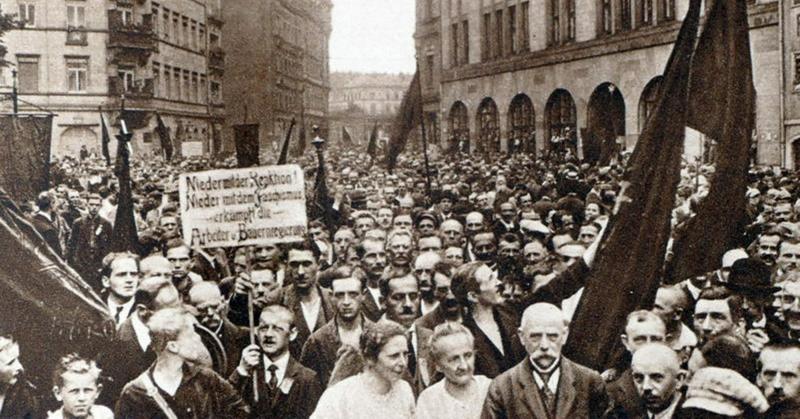The Anti-Fascist Congress of the United Front Who Were Sent To Concentration Camps Soon After
By | October 18, 2020

Fascism as an ideology came into major prominence in the early 20th century when Italian dictator Benito Mussolini founded the Fasces of Revolutionary Action movement in 1915, and the extreme far-right ideology has proven to be quite destructive throughout history. Fascist regimes often turn violent against their own citizens and those of neighboring countries, the most famous example being, of course, that of Hitler and the Nazi Party.
While the rise of fascism throughout the last century has been thoroughly studied, the power of its influence and the characteristics of its philosophy are still hotly debated among historians. We do know one thing, though, and that is so long as there have been fascist movements, anti-fascists movements have been quick on their heels.
Fascism In Germany
Let's hitch a ride in our time machine back to the 1930s, when Germany was having all kinds of political strife. Back in the '20s, the Weimar Republic was ruled by the Social Democratic Party, but then came along the Communist Party and the Nazi Party, who both thought they could do a better job at pulling people out of the economic depression the country was suffering as a result of Germany's loss in World War I.
While the Communists and Nazis fought each other, they also managed to push the Socialist Democrats out of power, and of course, we all know who came out on top of that philosophical wrestling match. Although Socialist Democrats and Communists had very different ideologies, the Communists made the grave error of believing that these "social fascists" were in any way comparable to the actual fascists that compromised the eventual Third Reich. This political divide basically left the road clear for Hitler to drive his tanks down.

The Brownshirts
One key factor in Hitler's rise to power was the use of a paramilitary police organization called "Sturmabteilung," which translates to "Storm Unit," but they're most often referred to as "Brownshirts" or simply "the SA" in English. This group originated somewhat organically, as financial restraints from the aftermath of the Versailles Treaty shrank the military down to as little as 100,000 men. Many enraged former soldiers banded together, threw their support behind Hitler, and began acting on his behalf in an unofficial capacity.
In reaction to massive inflation and perceived incompetence on the part of the Weimar Republic, SA members and other Nazi supporters attempted to stage a coup d’état against the Bavarian state government in November 1923. Although their initial attempt to take over Germany was a fantastic failure and Hitler was imprisoned in 1924 (for only nine months, somehow), they still managed to make a forceful comeback.
By the early 1930s, the Brownshirts vastly outnumbered the soldiers of the actual German military, which proved extremely dangerous for pretty much everyone who was not a Nazi or Nazi sympathizer. In 1931, the SA was exalted to legitimacy when Hitler appointed the extremely devoted Ernst Rohm to the head of the brutal organization. Over the years, the SA became infamous for harassing and beating people, especially Jews. In response, the still-surviving Communist Party called to action an anti-fascist coalition through the German newspaper Die Rote Fahne (The Red Flag) in 1932.

The Anti-Fascist Congress Of The United Front
The newspaper sparked the creation of the loosely organized Antifaschistische Aktion movement, which urged the people to take to the streets to combat fascism and the SA—and they meant "combat" in literal, physical terms. Anti-fascist groups of the time were involved in a number of street brawls, rallies, and violent protests.
They held their largest known rally in summer 1932, in a meeting called the Anti-Fascist Congress of the United Front (or sometimes, the Unity Congress), where they unified and mapped out strategies. They went on to establish coalitions which stemmed wrongful evictions and promoted boycotting as a form of political protest. While the group was initially born out of the Communist Party, many of the later participants were simply people who wished to fight back against the growing Nazi police state that used violence and intimidation as a means to gain power.

The Death And Rebirth Of Anti-Fascism
However constant the battle was between the anti-fascists and Brownshirts, it was actually Hitler himself who took the lives of the people most loyal to him. Worried that the Brownshirts were growing too chaotic and leadership in the organization was going astray, Hitler ordered the elite Schutzstaffel, or SS, soldiers to take out the Sturmabteilung on June 30, 1934. During this "Night of the Long Knives," basically every prominent leader of the Brownshirts was killed, including Rohm, as well as hundreds of people who Hitler believed to be potential political opponents.
The SS then overtook the police and established their own methods of law enforcement, often focusing on the control and eventual capture of Jewish people, among others. After the Night of the Long Knives, Hitler's power was all but cemented, and the only choices left to the anti-fascists were to fight, flee, or fall in line. Those who did fight were arrested and sent to the concentration camps, where they often met their horrific demise.
While Antifaschistische Aktion movement didn't quite achieve its mission of stopping the Third Reich, anti-fascist organizations of the '20s and '30s still had a major cultural impact through their legacy of protests and popularization of certain iconography. For example, the raised, clenched fist has become a catch-all symbol and gesture of solidarity, usually meant to signal a stand against authoritarianism or oppression. In a practical sense, the use of a clenched fists as a rebuttal to the Nazi salute (originally Roman salute) is what led to many Berlin street fights in the first place. In a broader sense, the gesture has endured throughout the generations, most notably during the Spanish Civil War, the 1960s Black Power movement, and most recently, the Black Lives Matter protests.

